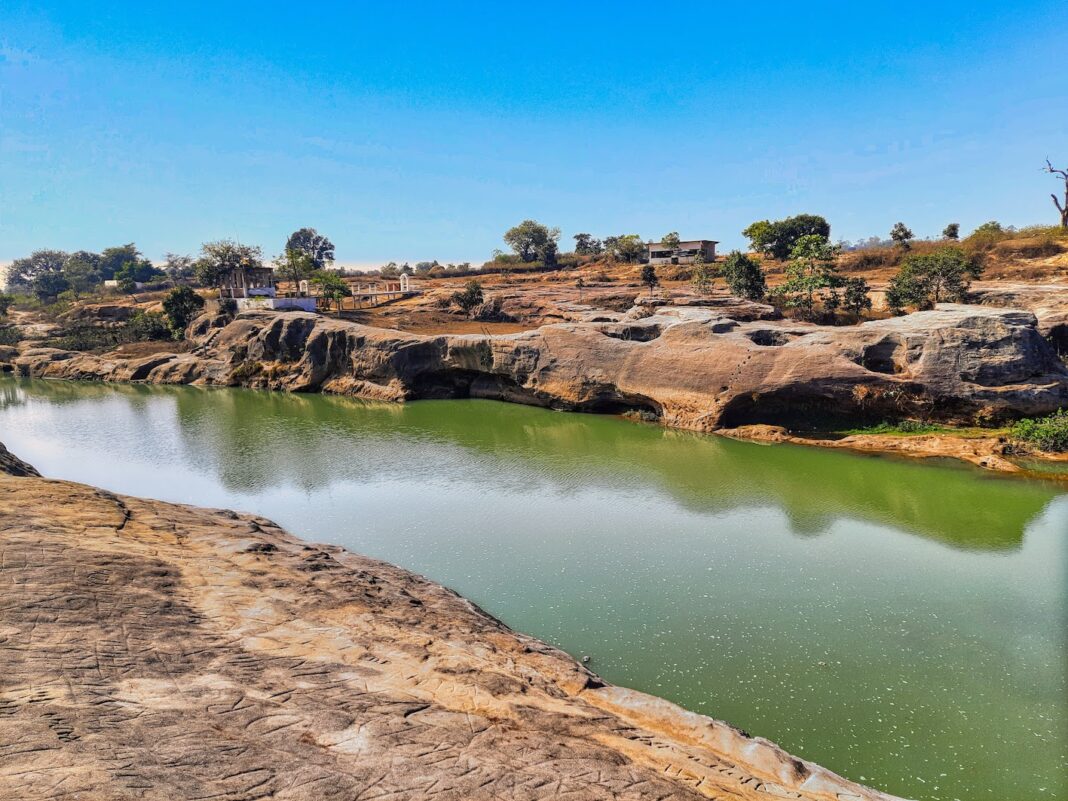Introduction Silhara Caves are a group of five artificial rock-cut caves located on the east bank of the Kewai River. It falls under the Kotma block of the Anuppur district of Madhya Pradesh. The caves were first documented by Hirananda Sastri in 1927-28.1 However, his focus was only on its inscriptions. He tells the name of the caves seems derived from Silagriha, meaning “mountain house”.
Caves: Of the original five caves, one cave has survived only in its traces. Of the remaining four, only three caves have well-survived and these are named, Sitamadi, Durvasa, and Cheri-Godadi. These three caves have inscriptions, the last fourth cave does not carry any inscription.
Durvasa Cave – The cave has been converted into a temple dedicated to Hanuman. Its front facade is supported by a single pillar, and modern-age figures of Hanuman are carved on the two faces of the pillar. From inside, the cave is a large rectangular hall supported by a row of pillars running across the periphery. The images and graffiti are all of the later period work and are heavily influenced by the local culture. The inscription in the cave tells the cave was excavated as a pleasure hill house by the minister Muladeva.
Sitamadhi Cave – This cave is in form of an open rectangular hall, the ceiling of which is supported by five pillars. A cell is excavated in one lateral wall, inside that are kept some broken medieval sculptures. The presence of stone beds inside the cell suggests that the cave was used for residential purposes and its accompanying inscription also suggests the same.
Cheri-Godadi Cave – This cave also appears as a residential cave as a stone bed is carved against its lateral wall. The cave also carries an inscription mentioning this silagaha or rock mansion was excavated by minister Muladeva.
Inscriptions: These inscriptions were first published in 1927-28 in the annual report of the Archaeological Survey of India. Some of these inscriptions are in Brahmi letters and a few in the Shell characters, the latter is undeciphered. There are seven Brahmi inscriptions, one in the Durvasa cave, two in the Cheri-Godadi cave, and four in the Sitamadhi cave. All these records are complete however the longest is of the Durvasa cave. These, except for two inscriptions in the Sitamadhi cave, may be dated to the middle of the 1st century CE. The remaining two inscriptions in the Sitamadhi cave can be dated to the 2nd century CE. The object of the inscriptions is to record the excavation of caves by Amatya Maudgaliputra Muladeva of the Vatsa-gotra, while Svamidatta was the ruler of the kingdom. Muladeva was the son of Sivamitra, grandson of Sivadatta, and great-grandson of Sivanandi. The excavations of Cheri-Godadi and Sitamadhi are told as silagaha or “rock mansions” but the excavation of Durvasa is called aramam pavate or “pleasure-house on the hill”. The two second-century CE inscriptions in the Sitamadhi cave reads, “yuvati-male” meaning “a high or elevated ground for meeting young women”, and “Udaya-Tara”, probably the name of a woman artist. This led Bhandarkar to suggest that these caves were excavated for sportive and merry-making purposes and continued as such for at least a century more. Taking the matronymic addressing of Muladeva and comparing it with similar addresses in other inscriptions of that period, Bhandarkar concludes the Durvasa cave inscription as proof of an inter-caste marriage between a Brahmana and Kshatriya group.2
- Inscription in the Durvasa Cave – reads, this aramam pavate (pleasure house) was excavated by Mogaliputra Muladeva, son of Sivamitra, grandson of Sivadatta, great-grandson of Sivanandi, during the reign of king Svamidatta. the inscription is dateable to the first century CE
- First inscription in the Cheri-Godadi cave – reads, this silagaha (rock mansion) was excavated by amatya Mogaliputra Muladeva, son of Sivamitra, grandson of Sivadatta, great-grandson of Sivanandi, the inscription is dateable to the first century CE
- Second inscription in the Cheri-Godadi cave – mentions the son of Sivamitra, grandson of Sivadatta, and great-grandson of Sivanandi, the inscription is dateable to the first century CE
- First inscription in the Sitamadhi cave – reads, this silagaha (rock mansion) was excavated by amatya Mogaliputra Muladeva, son of Sivamitra, grandson of Sivadatta, great-grandson of Sivanandi, the inscription is dateable to the first century CE
- Second inscription in the Sitamadhi cave – reads, the great-grandson of Sivanandi, Sivadatta, the inscription is dateable to the first century CE
- Third inscription in the Sitamadhi cave – reads, yuvati-male, a high hill place to meet women, the inscription is dateable to the second century CE
- Fourth inscription in the Sitamadhi cave – reads, Udaya-tara, probably the name of a woman artist, the inscription is dateable to the second century CE
1 Annual Report of the Archaeological Survey of India for the year 1927-28. pp. 136-138
2 Epigraphia Indica, Vol. XXII. pp. 30-36
Acknowledgment: Some of the photos above are in CC0 1.0 Universal Public Domain from the collection released by the Tapesh Yadav Foundation for Indian Heritage. Some of the photos above are in CC0 1.0 Universal Public Domain from the collection released by Tapesh Yadav Foundation for Indian Heritage.

